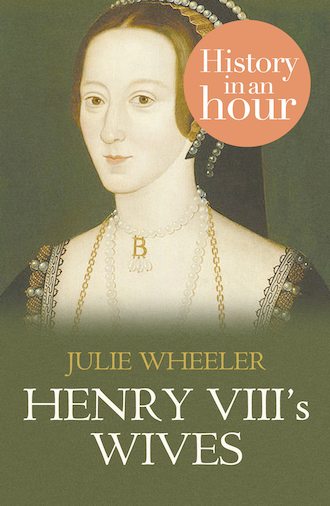
Полная версия
Henry VIII’s Wives: History in an Hour

HENRY VIII’S WIVES
History in an Hour
Julie Wheeler
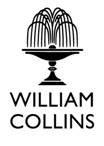
About History in an Hour
History in an Hour is a series of ebooks to help the reader learn the basic facts of a given subject area. Everything you need to know is presented in a straightforward narrative and in chronological order. No embedded links to divert your attention, nor a daunting book of 600 pages with a 35-page introduction. Just straight in, to the point, sixty minutes, done. Then, having absorbed the basics, you may feel inspired to explore further.
Give yourself sixty minutes and see what you can learn . . .
To find out more visit http://historyinanhour.com or follow us on twitter: http://twitter.com/historyinanhour
Contents
Cover
Title Page
About History in an Hour
Introduction
Katherine of Aragon
Anne Boleyn
Jane Seymour
Anne of Cleves
Katherine Howard
Katherine Parr
Appendix 1: Timeline of Henry VIII’s Wives
Copyright
Got Another Hour?
About the Publisher
Introduction
The reign of Henry VIII was one of the most revolutionary periods in English history. The king’s obsessive search for true love and intense desire for a male heir led to England’s break from the rule of Catholicism and the complete Reformation of the Church. ‘Divorced, Beheaded, Died; Divorced, Beheaded, Survived.’ This popular rhyme that many use to remember the fate of the six wives of Henry VIII shows us just that: their final destiny.
Although many rulers of the time married only for political reasons, Henry wanted an ideal we still crave today: a truly loving marriage. His quest for this improbable perfection changed him from a fun-loving prince into a belligerent tyrant, and his ever inflating ego ensured the changing passions he felt for the women in his life, and the heirs they may provide, were mixed with the type of play-acting that convinced him he was successful in the game of courtly romance.
The women whom he tried to squash to fit this perfect mould differed vastly. First came the devoutly Catholic and devoted Katherine of Aragon, then the tantalizing, volatile, Reforming Protestant Anne Boleyn. She in turn was ousted by the gentle and submissive touch of Jane Seymour. After her death, Henry made his only attempt at a wholly political alliance by choosing Anne of Cleves and he even tried to turn that into a romantic story. He went on to allow his heart free rein in the rule of his head in selecting the party-loving teenage tease, Katherine Howard, before finally settling for the intelligent and independent Katherine Parr.
This book, in an hour, will introduce you to these six entirely diverse and captivating personalities and the events that propelled them to their individual fates.
Katherine of Aragon
Born: 16 December 1485. Died: 7 January 1536. Queen: 24 June 1509–23 May 1533.
Katherine, or Catalina, to give her her Spanish name, was the youngest of five surviving children to Ferdinand of Aragon and Isabella of Castile, the so-called Catholic monarchs whose united regions made up most of modern-day Spain. Despite Ferdinand’s frequent infidelity, they enjoyed a loving marriage. The court they headed was often on the move as Isabella and Ferdinand were tireless military leaders who never flinched from taking their children on campaign. Katherine had a particularly close bond with her mother, who personally organized Katherine’s education, focusing on theology, Latin, modern languages, and traditional domestic craft. Latin was the language of the educated elite of Europe and so was of particular benefit when arranging a marriage among this group. Isabella offered no instruction in the courtly arts of poetry and music. The Dutch Humanist and renowned scholar, Desiderius Erasmus, praised her education, particularly her mastery of scholarship, despite the fact she was female! He wrote that Katherine ‘loves good literature, which she has studied with success since childhood’. On a separate occasion he wrote of her being ‘astonishingly well read, far beyond what would be surprising in a woman’.
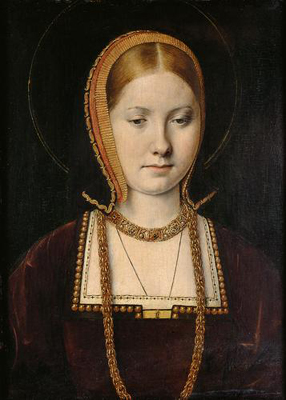
Young Katherine of Aragon, painted around the time of her arrival in England, by Michel Sittow
Katherine was just three years old when King Ferdinand made a marriage settlement for her as a way of enhancing family prestige. He and Henry VII of England (pictured below) held much in common: they both had recent experience in uniting their countries following extended civil wars, and they both wanted to outmanoeuvre France.
A matrimonial alliance between their children would unify their power against the French, encouraging national stability and, for the English, propagate a new dynasty. Henry VII was lucky enough to have two male heirs: Arthur and Henry. Arthur, the eldest, born in September 1486, was the natural choice to be Katherine’s husband.
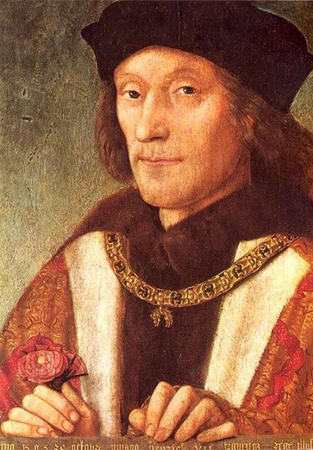
Henry VII, by Michel Sittow, painted in 1500. He holds the red rose of Lancaster
Ferdinand and Isabella agreed Katherine would come to the marriage with a dowry of 200,000 crowns, to be paid in two instalments. The first would be granted on her arrival in England, the second after the marriage ceremony. In return Henry agreed on a settlement of one-third of the lands of the Prince of Wales on Katherine. With half of Katherine’s dowry paid, the pair married on 14 November 1501 in St Paul’s Cathedral. She was nearly sixteen; Arthur was just fourteen.
Considerable effort went into the preparation of the marriage bedchamber and Katherine herself for the wedding night. Bishops used holy water and prayers to bless the bed, hoping many children would be conceived and a long, happy wedded union would ensue. It was assumed that once these rituals had been concluded and the couple were left alone, consummation would take place. There are stories of Arthur (pictured below) professing the joys of having a wife, even implying it was thirsty work. They could have been true, or merely the exaggerations of a teenage boy, but one day Katherine would come to refute them vehemently. The one thing we know he did say (and again it may have been teenage bravura) was this after the wedding night: ‘I have been this night in the midst of Spain’.
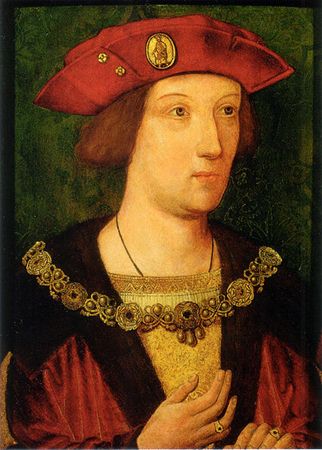
Arthur, Prince of Wales, painted around 1500 by an unknown artist
On 21 December 1501 Katherine and Arthur set off for Ludlow Castle, Arthur’s seat in Shropshire, to formally begin their wedlock with a Christmas feast. In the opening weeks of 1502 the marriage ran smoothly. Well-intentioned gossip circulated regarding Arthur’s unwearying diligence towards his conjugal obligation. But during Easter, he fell gravely ill. Evidence suggests some sort of respiratory problem, but there was also some contemporary terminology that indicates testicular cancer. Whatever had struck Arthur killed him quickly – he died on 2 April 1502, aged fifteen. Katherine, aged only sixteen, was already a widow.
Henry VII’s second son, Henry, Duke of York, became heir to the English throne. The possibility of him marrying Katherine was soon aired but, born on 28 June 1491, Henry was, at ten years old, not old enough to marry. Katherine was clearly too young to remain a widow, and King Henry VII not only wanted to retain the portion of Katherine’s dowry he had already received but also felt reluctant to sacrifice the remainder he was due had Arthur lived.
The sticking point of the affair was a theological question concerning the new match: could Katherine marry her brother-in-law in the eyes of God? The Bible gave conflicting opinions. The book of Leviticus clearly forbade it and warned that it would be a barren relationship; by contrast, the book of Deuteronomy encouraged such action so as to raise children for the dead brother. To ensure the legitimacy of the union and succession, it was time to turn to Rome.
Pope Julius II presided over the matter, albeit reluctantly, drawing up a dispensation in 1504 for the marriage to proceed legally. The document was backdated to 1503 and received at the court of England in 1505. It was believed that had the relationship between Arthur and Katherine been consummated this would have created what was known as an ‘affinity’, in other words Henry, in the eyes of the Church, and therefore, contemporary law, had become a real brother to Katherine. It was sexual relations and not a wedding ceremony that caused an affinity.
King Ferdinand remained committed to the Anglo-Spanish alliance. He willingly accepted Katherine’s word that she was still a virgin. After a few uncertain objections passed between the two powers, the wording for the dispensation was settled. The Latin word forsan was used. It does not translate exactly but rather ambiguously means ‘perhaps’ or ‘even if’. The dispensation was awarded on the basis that ‘perhaps’ the marriage had been unconsummated.
On 25 June 1503, the future Henry VIII (pictured below as a youth) and Katherine were formally betrothed. Two years later, Prince Henry had reached the legal age for marriage, but his father had cooled towards the idea of a Spanish alliance and insisted his son publicly renounce the betrothal. By this time Katherine’s mother, Isabella, and Henry’s mother, Elizabeth of York, had died. This left Katherine somewhat alone, a helpless pawn in a masculine world. The Spanish retort came: if Katherine was to be sent back to Spain then the dowry would have to be returned. At this point Henry VII began to prevaricate. He too was now in the market for a new spouse, as was Prince Henry’s youngest sister, the Princess Mary. The English king was determined to make the best possible strengthening alliances.
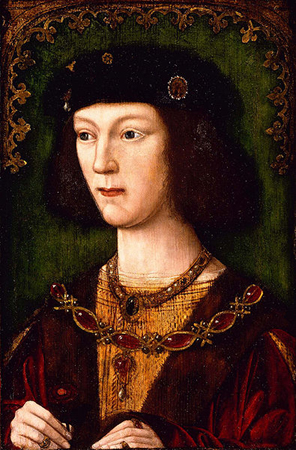
Young Henry VIII. Painted c. 1509, by an unknown artist
As King Henry VII dithered, he kept Katherine, along with her advisers and servants, isolated in the Bishop of Durham’s house, away from the devices of court politics, and left her to cope on minimal means. Henry was, in turn, misled and repeatedly let down by Ferdinand regarding the second portion of Katherine’s dowry. In fact, the settlement was not received by London until 22 February 1508. Katherine also experienced limited access to Prince Henry and was denied the privilege of being given confession in her own language. Her confessor, Alessandro, had been forced to leave the English court in 1503, and in 1506 correspondence to her father reveals desperate pleas for him to send her a Spanish friar. Katherine and her entourage continued to endure this existence until they despaired utterly of the marriage ever taking place. She even had to resort to pawning some of her jewels when her allowance was withdrawn. Later she moved to Richmond, and she was so upset and discomfited that she even asked to join a convent back home in Spain.
In April 1509 a stroke of luck befell them: Henry VII died. The new king, Henry VIII, decided to honour the 1503 betrothal. The only conditions implemented were that the dowry should be paid in full and King Ferdinand must agree it would not be returned should either Katherine or Henry die prematurely.
The couple shared a joint coronation on 24 June 1509. Katherine was twenty-three and Henry just days short of his eighteenth birthday.
In the first weeks of marriage they revelled in a joyous honeymoon that quickly resulted in pregnancy. It was common practice for an announcement to be withheld until midwives had confidently felt movement; accuracy was crucial, especially in the instance of a royal heir. In Katherine’s case public declaration was made on 1 November. Sadly, at the end of January 1510, the queen gave birth to a stillborn daughter. This was followed by a phantom pregnancy and then a real one. The court was jubilant when, on New Year’s Day 1511, a prince was born. Baby Henry was christened on 5 January. But again the royal couple were soon blighted by grief. Their son died, at just twenty-three days old.
The following years saw events across Europe become increasingly fractious as the English fought wars against France and Scotland. While Henry was on campaign in France, Katherine proved herself an excellent regent and, in the case of Scotland, a skilful military co-ordinator.
The only talent she seemed to lack was the ability to substantiate her maternal credentials. She is said to have conceived again in spring 1513, only to lose this son in September. A stillborn male came in 1514. Another pregnancy was confirmed in May 1515, which resulted in the birth of their only surviving child, Princess Mary, on 18 February 1516. By this time Katherine was well aware of her husband’s occasionally roving eye, although by the royal standards of the day, it was not quite as roving as it could have been.
Henry VIII had sustained romantic liaisons with at least two mistresses. Bessie Blount had had a healthy son whom Henry publicly recognized, and Mary Carey, née Boleyn had a son and a daughter that many attributed to the king but whom he never acknowledged. These attachments never induced Henry to separate from Katherine. But in 1526 things changed. Affinity aside, he had fallen in love with Mary Boleyn’s sister, Anne. The king began looking into the validity of his marriage to Katherine.
Anne Boleyn
Born: c. 1500. Died: 19 May 1536. Queen: 28 May 1533–17 May 1536.
In the 1520s no one could possibly have imagined how Anne was so cleverly to succeed where Henry’s previous extra-marital lovers had failed. Anne proved herself the ultimate career woman in a world where one of the few career choices for women was wedlock.
On her father’s side, Anne Boleyn’s lineage was made up of the merchant middle class. Her great-grandfather, Geoffrey Boleyn, was the family’s original entrepreneur. Trading success had made him mayor and he received a knighthood. He invested for his descendants by purchasing Blickling Hall in Norfolk and Hever Castle in Kent. The following Boleyn men married well, none more so than Geoffrey’s grandson, and Anne’s father, Thomas Boleyn. He married Elizabeth Howard, daughter of the second Duke of Norfolk, whose ancestry was peppered with dukes and earls.
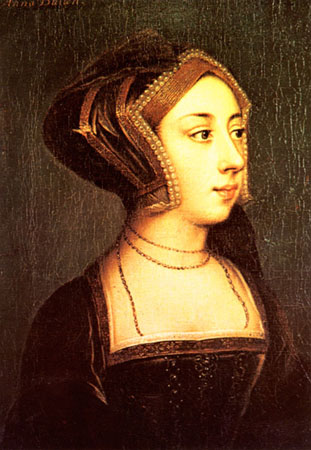
This painting is inscribed with ‘Anna Bullen at Hever Castle’ and there is uncertainty on the date and artist
Anne’s parents married by 1500. They then had their three children in quick succession; Mary, Anne and George. There is no certainty for Anne’s date of birth, but she was born around 1500, certainly by 1503.
Thomas’ political talent enabled him to join the royal service where he excelled and earned continued promotion, becoming a servant of the body for Henry VIII and a knight of the Bath. Having worked on matters of state at the court of Margaret, Duchess of Savoy, in Brussels, Thomas was able to secure a position there for his daughter, Anne. This appointment saw Anne flourish and her father clearly recognized her emerging talents. She understood courtly politics and was rapidly learning French. In 1514 Anne was transferred to the court of France. Here, she was able to develop her burgeoning skills.
Anne loved the French language and soon became fluent. She learnt how to impress with music and poetry. French culture enabled her to become a clever conversationalist and release a ready wit. She also mastered the skill of overt flirtation without damaging her chaste reputation.
Anne Boleyn was a vivacious, cultured and fascinating young woman by the time she was recalled to England in 1521 to marry James Butler, both a cousin and heir to the Earl of Ormonde. There was some dispute as to whether Thomas Boleyn should inherit this earldom and so, in agreement with King Henry VIII, this marriage offered the solution. As lengthy negotiations regarding the wedding were carried out, Anne took a position in the English court as one of Queen Katherine’s maids. The first recorded appearance of Anne at the English court was Shrove Tuesday, 1 March 1522, in a masque in which she was cast as Perseverance.
Cardinal Thomas Wolsey (pictured below), as lord chancellor, had some say in court matters, including marriages, but despite his efforts, the marriage agreement between Anne and James did not reach fruition. It is believed that differences between Thomas Boleyn and Piers Butler, James’ father, had become irreconcilable.
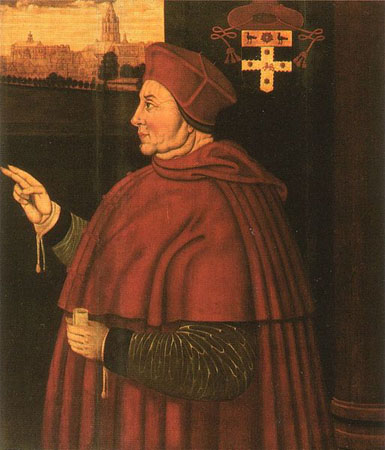
Cardinal Thomas Wolsey, painted by Sampson Strong around 1526 at Christ Church
As far as finding another suitor was concerned Anne would have no problem. French-styled manners and accomplishments were fashionable within the English court during the 1520s, and Anne effortlessly became a celebrated member of Queen Katherine’s entourage. She was romantically linked to the poet Thomas Wyatt, who became besotted with her (although it is doubtful whether the interest was reciprocated except in the courtly way). Wyatt had already taken advantage of an arranged marriage and here, for the first time, Anne Boleyn clearly demonstrated that an aspirational marriage was her plan, not a sullied reputation as a mistress. She focused her ambitious energy upon another match.
Henry Percy was the wealthy son and heir to the Earl of Northumberland, also under the influence of Cardinal Wolsey. A loving romance blossomed between Anne and Percy and they entered into a secret betrothal. Unfortunately the couple were unaware that Percy’s father, the earl, had already negotiated a betrothal for his son to marry Mary Talbot, daughter of the equally wealthy Earl of Shrewsbury, and he fully intended his son to honour the contract. The cardinal called a halt on plans between Anne and Henry Percy. Besides, it was around the same time as James Butler was being proposed for Anne.
The question remains: did Cardinal Wolsey prevent the marriage of Anne and Percy to appease the Earl of Shrewsbury or because King Henry VIII had fallen for Anne himself by this time and had ordered him to so? Henry Percy was forced to marry Mary Talbot regardless of the heartbroken protests that he and Anne proffered. The vehemence of Anne’s protestations resulted in her being removed from court by her family during the summer of 1525. By autumn she was allowed to return. Whether Henry VIII was responsible for enforcing the separation of Percy from Anne or not, he was now able to pursue her unhindered.
Having set her sights on becoming a wife, Anne demonstrated to Henry that he could not control her head or heart. She expertly kept him dangling for more than a year, using all her courtly skills, giving nothing real away. During this time Henry inundated Anne with love letters full of promises, declarations and presents. The response he received often left him perplexed and, along with her refusal to sleep with him, inflamed his passion to a level he had not previously encountered. Bessie Blount and Mary Boleyn had been comparative walkovers.
Конец ознакомительного фрагмента.
Текст предоставлен ООО «ЛитРес».
Прочитайте эту книгу целиком, купив полную легальную версию на ЛитРес.
Безопасно оплатить книгу можно банковской картой Visa, MasterCard, Maestro, со счета мобильного телефона, с платежного терминала, в салоне МТС или Связной, через PayPal, WebMoney, Яндекс.Деньги, QIWI Кошелек, бонусными картами или другим удобным Вам способом.




